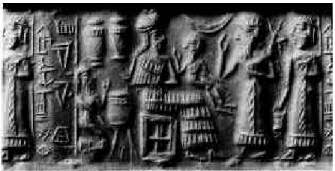While
the Harappans are known to have exported many commodities to Mesopotamia,there
is no evidence of what they received in exchange,One possibility is woollen
textiles,a major Mesopotamian export that would have left no archaeological trace.Wool-bearing
sheep had been bred in Mesopotamia in the 4th millennium BC but,although they
quickly spread through Europe and into the steppe,it is not known if they
spread east before the 2nd millennium BC.An initial study of published faunal
data indicates that the Harappans were probably not raising sheep for wool and
therefore may not have had wool-bearing sheep,So Mesopotamian woollen textiles
may well have been a desirable import.Therefore we can safely assume that
Sumerians exported mostly textiles and crops,while the Harappans traded in
lumber,copper,gold and ivory,which were bought by the Sumerian royalty.Both
civilizations made great advances in transportation in order to carry their
merchandise with greater ease.The Sumerians appear to have
developed the wheel
and possibly the sailboat and the Harappans developed ox-carts and small
flat-bottomed boats all of which were used commercially.Perhaps it is because
of the extensive trade between the two civilizations that they developed
similarly in many areas.Also There is a reference by Sargon of Agade (2334–2279
BCE) that the ships of Meluhha,Magan and Dilmun were coming up to Akkad (Agade)
as:‘the ships from Meluhha,the ships from Magan,the ships from Dilmun,He made
tie-up alongside quay of Akkad.’ The references in the Akkadian records to the
ships of Dilmun, Magan and Meluhha tied up in the quay of Akkad showed that the
Harappans had their reach directly in this region.Further,the cylindrical seal
depicting a Meluhhan interpreter of the Old Akkadian period further
substantiated the possibility of Harappan settlements or colonies in the
Mesopotamian land to further their trade-related activities.The necessity for
an interpreter could be for multifarious purposes.An interpreter was needed if
delegations or important dignitaries visited a foreign land with an unfamiliar
language and culture.Hence there was a strong possibility that Harappan
settlements or groups of Harappan merchants were actually present in
Mesopotamia.They could have carried along with them large quantities of native
pottery and products,apart from the items of trade.This was reflected by the
findings of typical Harappan pottery from sites in Oman.If Harappan pottery could be found at sites in Oman, and, if Harappan trade items and seals could be found at sites in Mesopotamia and Iran,there was every possibility to find evidence related to a Harappan settlement or colony or a temporary occupation from the sites they could have actually visited.This possibility,along with the evidence of a Meluhhan interpreter,fully strengthened the possibility of the presence of a bilingual inscription from this region.So It has become absolutely necessary[imperative] now to sift[To examine and sort carefully] through the enormous quantity of archaeological data from the Mesopotamian sites by Harappan archaeologists to segregate[isolate] the Harappan material present if any.
Modern
studies into the pre-historic Indus/Saraswati valley culture of north western
India and Pakistan,centred on Harappa and Mohenjo Daro, suggest that the
imperfectly understood script of these cities is of a proto-Dravidian
nature.This leads us to conclude that the Dravidians are not indigenous to
South India,but moved there at some point in time after the collapse of the Indus/Saraswati
civilisation in about 1,700 BC.Many Tamils trace their origins to the people of
Mohenjodaro in the Indus Valley.Also More evidence of who the Indus Valley
people were is found in the translations of the Vedas (which were written by
the Aryans who came to India some 3500 years ago) There is, however, a need for further
systematic study of the history of the early Tamils and proto Tamils. As the
Indus/Saraswati script has yet to be translated,it is difficult to establish
who these people were and from whence they originated.This uncertainty follows
because of the undeciphered nature of the Indus script.
According
to Professor Romilar Tharpar, in her seminal work "Early India, From the
Origins to AD 1300", the word 'Mlechcha' is still used in India today by
the Hindi-speaking, Aryan descendent northerners to refer to those who are
beyond the caste system, or ritually impure.This clearly indicates that the
Meluhans were not Aryan and inhabited India before the caste structure brought
by the Aryans was in place.The Meluhans were described in Sumerian literature
as being from 'a black land', or being a black people.This has led western
scholars, unaware of the close association between caste and colour, to look in
Africa for Meluha. Ritually as well as visually,the Meluhans were beyond
caste,and therefore 'black' to the Aryans - in other words,they were
Dravidians.
PART :56 WILL FOLLOW













0 comments:
Post a Comment